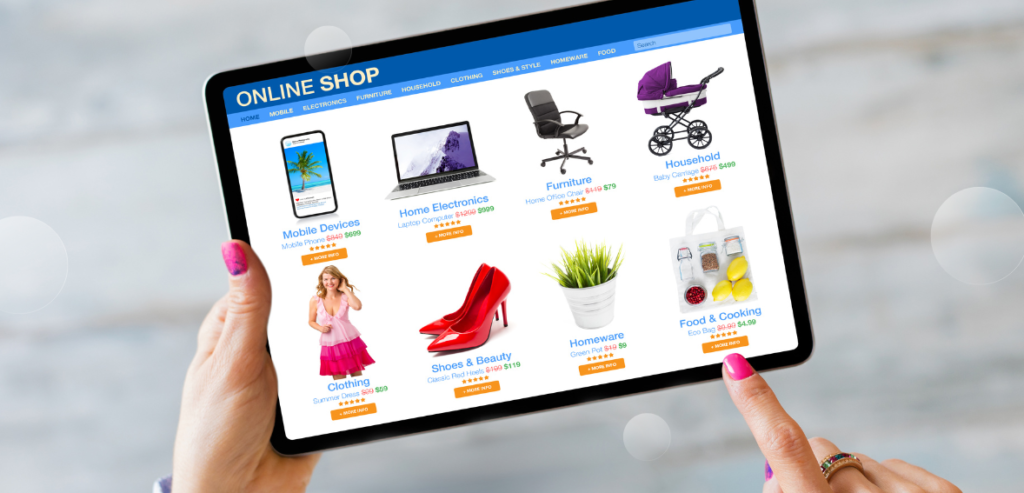Personalized ecommerce shopping refers to customizing the online shopping experience for each user based on their behavior, preferences, and history. It involves analyzing customer data and using it to provide a personalized shopping experience to increase customer satisfaction, loyalty, and revenue.
In personalized ecommerce shopping, businesses use data such as customer demographics, search history, purchase history, and social media activity to create personalized product recommendations, personalized marketing messages, and personalized landing pages. This approach allows businesses to present their products and services in a more relevant and engaging way to the customer, which can lead to higher conversion rates and customer satisfaction.
Why is Personalized Ecommerce Shopping Important?

Personalization is becoming increasingly important in the world of e-commerce. Here are some of the key reasons why:
1. Boosting Conversion Rates
Personalization can help businesses increase their conversion rates by presenting their products and services in a more relevant and engaging way to the customer. Companies can create personalized product recommendations, marketing messages, and landing pages using customer demographics, search history, and purchase history. This can build customer trust, increase engagement, and drive more sales.
2. Increasing Customer Loyalty
Personalization can also help businesses build stronger customer relationships, increasing loyalty and lifetime value. By providing personalized experiences, businesses can show their customers that they are valued as individuals and that their needs and preferences are being considered. This can create a positive emotional connection between the customer and the brand, leading to increased loyalty and repeat business.
3. Enhancing User Experience
Personalization can also enhance the overall user experience of an e-commerce website. By presenting customers with personalized product recommendations, personalized marketing messages, and personalized landing pages, businesses can create a more seamless and enjoyable shopping experience. This can reduce friction in the purchasing process, increase engagement, and ultimately drive more sales.
Personalization is becoming increasingly important in e-commerce as businesses look to stay competitive in a crowded market. By using customer data to create personalized experiences, businesses can boost conversion rates, increase customer loyalty, and enhance the overall user experience of their website.
Types of E-Commerce Personalization

There are several types of e-commerce personalization, including:
1. Behavioral Personalization
Behavioral personalization involves data on a customer’s behavior, such as browsing and purchasing history, to provide personalized product recommendations and marketing messages. For example, customers who frequently purchase running shoes may receive personalized recommendations for new running shoes or other running-related products. Behavioral personalization can help businesses create a more engaging and relevant shopping experience for their customers, leading to higher conversion rates and customer satisfaction.
2. Demographic Personalization
Demographic personalization involves using data on a customer’s demographic characteristics, such as age, gender, and location, to provide personalized product recommendations and marketing messages. For example, customers in a cold climate may receive personalized recommendations for winter clothing or accessories. Demographic personalization can help businesses create more targeted and relevant marketing campaigns, leading to higher conversion rates and customer loyalty.
3. Contextual Personalization
Contextual personalization involves using data on a customer’s current context, such as their location, device, and time of day, to provide personalized product recommendations and marketing messages. For example, a customer browsing a mobile device may be presented with customized recommendations for mobile-friendly products or services. Contextual personalization can help businesses create a more seamless and enjoyable shopping experience for their customers, leading to higher conversion rates and customer satisfaction.
There are several types of e-commerce personalization, including behavioral, demographic, and contextual. Businesses can use customer data to provide personalized product recommendations and marketing messages to create a more engaging, relevant, and seamless shopping experience, leading to higher conversion rates, customer loyalty, and revenue.
E-Commerce Personalization Techniques
Businesses can use several e-commerce personalization techniques to provide customers with a more engaging and relevant shopping experience. Here are some of the essential methods:
1. Product Recommendations
Product recommendations involve using data on a customer’s browsing and purchasing history to provide personalized recommendations for products or services they may be interested in. This can be done using algorithms that analyze customer data to identify patterns and make recommendations based on those patterns. Product recommendations can increase customer satisfaction and loyalty by providing a more relevant and engaging shopping experience.
2. Dynamic Content
Dynamic content involves tailoring the content of a website or marketing message based on a customer’s behavior or preferences. For example, a website may display different content to a returning customer than to a first-time visitor. Dynamic content can create a more personalized and engaging customer experience, leading to higher conversion rates and customer satisfaction.
3. Segmentation
Segmentation involves dividing customers into groups based on demographic or behavioral characteristics and tailoring marketing messages and product recommendations to each group. For example, a company may segment customers based on age, gender, or location and provide personalized marketing messages and product recommendations to each segment. Segmentation can create a more targeted and relevant shopping experience for customers, leading to higher conversion rates and customer loyalty.
4. Email Personalization
Email personalization involves tailoring marketing emails to customers based on their behavior or preferences. This can include personalized product recommendations, special offers, and other incentives. Email personalization can increase open and click-through rates, customer loyalty, and revenue.
5. Abandoned Cart Recovery
Abandoned cart recovery involves sending personalized messages to customers who have left items in their shopping cart without completing a purchase. These messages may include personalized product recommendations or incentives to complete the purchase. Abandoned cart recovery can help to increase conversion rates and customer loyalty by reminding customers of products they may be interested in and encouraging them to complete their purchases.
Businesses can use several e-commerce personalization techniques to create a more engaging and relevant customer shopping experience. Businesses can increase customer satisfaction, loyalty, and revenue by using product recommendations, dynamic content, segmentation, email personalization, and abandoned cart recovery.
Best Practices for Implementing E-Commerce Personalization
Implementing e-commerce personalization can be a complex process, but there are some best practices that businesses can follow to ensure success. Here are some of the key practices:
1. Collect and Analyze Customer Data
The first step in implementing e-commerce personalization is to collect and analyze customer data. This can include data on customer behavior, preferences, and demographics. By collecting and analyzing this data, businesses can gain insights into customer needs and interests, which can be used to create more targeted and relevant marketing messages and product recommendations.
2. Implement a Personalization Platform
To effectively implement e-commerce personalization, businesses should consider using a personalization platform. A personalization platform can automate the collection and analysis of customer data, providing tools for creating personalized product recommendations and marketing messages. It can help businesses scale their personalization efforts and provide a more seamless and effective shopping experience for their customers.
3. Test and Optimize
To ensure that e-commerce personalization efforts are practical, businesses should continually test and optimize their strategies. This can involve A/B testing, user feedback, and data analysis to identify what is working and what can be improved. By continually testing and optimizing, businesses can ensure that their personalization efforts drive customer satisfaction, loyalty, and revenue.
4. Ensure Data Privacy
When collecting and analyzing customer data, it is essential to ensure data privacy and security. Businesses should follow best practices for data protection, such as encrypting data, limiting access to sensitive data, and obtaining customer consent for data collection and use. Data privacy can help build customer trust and avoid legal and reputational risks.
5. Provide Omnichannel Personalization
Finally, businesses should consider providing omnichannel personalization, which involves creating a seamless and personalized shopping experience across all channels and devices. This can include personalizing marketing messages and product recommendations across email, social media, and mobile apps. By providing omnichannel personalization, businesses can create a more consistent and engaging customer shopping experience.
E-commerce personalization requires collecting and analyzing customer data, implementing a personalization platform, testing and optimizing, ensuring data privacy, and providing omnichannel personalization. By following these best practices, businesses can create a more engaging and relevant shopping experience for their customers, increasing customer satisfaction, loyalty, and revenue.
Measuring the Success of E-Commerce Personalization
Measuring the success of e-commerce personalization is essential to determine the effectiveness of the implemented strategies. Here are some key metrics that can be used to measure the success of e-commerce personalization:
1. Conversion Rate
Conversion rate refers to the percentage of visitors to an e-commerce site who make a purchase. By tracking the conversion rate before and after implementing e-commerce personalization, businesses can determine whether their personalization efforts are leading to an increase in conversions.
2. Average Order Value (AOV)
Average order value (AOV) refers to the average money customers spend in a transaction. By tracking AOV before and after implementing e-commerce personalization, businesses can determine whether personalized product recommendations and marketing messages increase average order value.
3. Customer Retention Rate
Customer retention rate refers to the percentage of customers who purchase from an e-commerce site over time. By tracking customer retention rates before and after implementing e-commerce personalization, businesses can determine whether personalized experiences increase customer loyalty and repeat business.
4. Bounce Rate
Bounce rate refers to the percentage of visitors to an e-commerce site who leave without taking any action, such as making a purchase or clicking on a link. By tracking bounce rates before and after implementing e-commerce personalization, businesses can determine whether personalized experiences are leading to a decrease in bounce rate and an increase in engagement.
5. Time on Site
Time on site refers to the time visitors spend on an e-commerce site. By tracking time on site before and after implementing e-commerce personalization, businesses can determine whether personalized experiences lead to increased engagement and a more enjoyable shopping experience for customers.
The success of e-commerce personalization can be measured by tracking conversion rate, average order value, customer retention rate, bounce rate, and time on site. By analyzing these metrics before and after implementing e-commerce personalization, businesses can determine the effectiveness of their personalization strategies and make informed decisions about future efforts.
Ecommerce Elements You Can Personalize
Businesses can personalize several e-commerce elements to create a more engaging and relevant customer shopping experience. Here are some of the key elements:
- Product Recommendations: Businesses can provide personalized product recommendations using customer browsing and purchasing history data. This can involve recommending products similar to ones the customer has already purchased or viewed or recommending products that other customers with similar interests have purchased.
- Marketing Messages: Businesses can create more targeted and relevant campaigns by tailoring marketing messages to each customer. This can involve using data on a customer’s behavior or preferences to create personalized email campaigns, social media ads, or other marketing messages.
- Landing Pages: By personalizing landing pages based on a customer’s behavior or preferences, businesses can create a more engaging and relevant shopping experience. This can involve tailoring landing pages to specific customer segments or using dynamic content to show different content based on a customer’s previous interactions with the site.
- Recommendations for Add-Ons or Related Products: Businesses can increase average order value and customer satisfaction by providing personalized recommendations for add-ons or related products. This can involve recommending complementary products based on the customer’s purchase history or browsing behavior.
- Search Results: By personalizing search results based on a customer’s behavior or preferences, businesses can create a more relevant and efficient shopping experience. This can involve using data on a customer’s past search queries and purchase history to provide personalized search results.
Businesses can personalize several e-commerce elements to create a more engaging and relevant customer shopping experience. By personalizing product recommendations, marketing messages, landing pages, recommendations for add-ons or related products, and search results, businesses can increase customer satisfaction, average order value, and revenue.
What’s the Best Way for an Ecommerce Business to Accept Payments?
Choosing the best way for an e-commerce business to accept payments depends on several factors, such as the company’s size, the types of products or services offered, and the target market’s preferences. Here are some of the most common options:
- Credit and Debit Cards: Credit and debit card payments are accepted as standard and convenient options for e-commerce businesses. This can involve setting up a merchant account with a payment processor like PayPal or Stripe and integrating the payment gateway into the e-commerce site.
- E-Wallets: E-wallets, such as Apple Pay, Google Wallet, or Amazon Pay, can provide a convenient and secure option for customers to make payments. E-wallets can be integrated into the e-commerce site, and customers can use their stored payment information to make purchases without having to enter their payment details every time.
- Bank Transfers: Bank transfers allow customers to make payments directly from their bank accounts. This can involve setting up a direct debit system or providing customers with a bank transfer option at checkout.
- Cryptocurrencies: Accepting payments in cryptocurrencies, such as Bitcoin or Ethereum, can provide customers with a decentralized and secure option. This can involve setting up a cryptocurrency wallet and integrating it into the e-commerce site.
- Installment Plans: Offering installment plans can allow customers to make larger purchases over time, increasing sales and customer loyalty. This can involve partnering with a financing company or setting up a financing option in-house.
The best way for an e-commerce business to accept payments depends on several factors. By considering the size of the business, the types of products or services offered, and the target market’s preferences, businesses can choose the payment options that work best for them and their customers.
Ecommerce Personalization Examples
E-commerce personalization can take many different forms. Here are some examples of how e-commerce businesses can use personalization to create a more engaging and relevant shopping experience for their customers:
- Product Recommendations: Amazon is a well-known example of a company that uses personalized product recommendations to drive sales. By analyzing a customer’s browsing and purchasing history, Amazon can provide personalized product recommendations tailored to each customer’s interests and needs.
- Dynamic Content: Coca-Cola’s Share a Coke campaign is a great example of how dynamic content can create a personalized customer experience. By printing customers’ names on Coca-Cola bottles and cans, Coca-Cola created a more engaging and personalized experience that resonated with customers.
- Personalized Email Campaigns: Online retailer, ASOS, uses personalized email campaigns to provide customers with tailored product recommendations and promotions. By analyzing a customer’s browsing and purchasing history, ASOS can send personalized, more relevant, and engaging emails to each customer.
- Targeted Landing Pages: Online shoe retailer, Zappos, uses targeted landing pages to provide a more personalized experience for customers. Zappos can provide landing pages tailored to each customer’s interests and needs by analyzing a customer’s browsing and purchasing history.
- Personalized Offers: The travel website, Booking.com, uses personalized offers to create a more engaging and relevant customer experience. By analyzing a customer’s previous booking history, Booking.com can provide personalized offers tailored to each customer’s travel interests and preferences.
E-commerce businesses can use personalized product recommendations, dynamic content, email campaigns, targeted landing pages, and personalized offers to create a more engaging and relevant shopping experience. By leveraging customer data to create a personalized experience, businesses can increase customer satisfaction, loyalty, and revenue.
Final Thoughts
E-commerce personalization can provide several benefits for businesses, including increased customer satisfaction, loyalty, and revenue. By tailoring the shopping experience to each customer’s interests and needs, businesses can create a more engaging and relevant experience that resonates with customers.
To implement e-commerce personalization effectively, businesses should consider collecting and analyzing customer data, using a personalization platform, testing and optimizing their strategies, ensuring data privacy, and providing omnichannel personalization.
Businesses can personalize many e-commerce elements, including product recommendations, marketing messages, landing pages, recommendations for add-ons or related products, and search results. By leveraging these personalization techniques, businesses can increase customer satisfaction, average order value, and revenue.
When accepting payments, businesses should consider the size, the types of products or services offered, and the target market’s preferences. Credit and debit cards, e-wallets, bank transfers, cryptocurrencies, and installment plans are all viable payment options businesses can consider.
To succeed in e-commerce, businesses must stay up-to-date with the latest trends and techniques in e-commerce personalization. By continually optimizing their strategies and implementing best practices, businesses can create a more engaging and relevant shopping experience for their customers, increasing customer loyalty and revenue.

